Difference between revisions of "Mount Emei" - New World Encyclopedia
Dan Davies (talk | contribs) |
Rosie Tanabe (talk | contribs) |
||
| (36 intermediate revisions by 4 users not shown) | |||
| Line 1: | Line 1: | ||
| − | {{images OK}} | + | {{approved}}{{submitted}}{{ready}}{{images OK}}{{copyedited}} |
| − | {{ | + | |
{{Infobox World Heritage Site | {{Infobox World Heritage Site | ||
| WHS = Mount Emei Scenic Area, including Leshan Giant Buddha Scenic Area | | WHS = Mount Emei Scenic Area, including Leshan Giant Buddha Scenic Area | ||
| Line 13: | Line 13: | ||
| Link = http://whc.unesco.org/en/list/779 | | Link = http://whc.unesco.org/en/list/779 | ||
}} | }} | ||
| + | {{ZHdot|Mount Emei}} | ||
| + | '''Mount Emei''' ({{zh-cpw|c=峨嵋山|p=Éméi Shān|w=O<sup>2</sup>-mei<sup>2</sup> Shan<sup>1</sup>}}, literally ''towering Eyebrow Mountain'') is located in [[Sichuan]] province, Western [[China]]. Mount Emei is often written as 峨眉山 and occasionally 峩嵋山 or 峩眉山 . All three translate as Mount Emei or Mount Emeishan. Mount Emei numbers among the four holiest [[Buddhist sacred mountains|Buddhist mountains]] and five holiest [[Taoist sacred mountains|Taoist mountains]] in China. [[Samantabhadra]], the Lord of Truth, resides as the patron [[Bodhisattva]] on Mount Emei. The [[Shaolin Monastery]] on Mount Emei had long been the home of [[Chinese martial arts]]. | ||
| + | {{toc}} | ||
| + | The first [[Buddhist monasteries]] were built on Mount Emei during the first century C.E. Their [[architecture]] is famous for blending into the natural scenery. Seventy Buddhist monasteries built during the [[Ming Dynasty|Ming]] and [[Qing Dynasty|Qing]] dynasties are located in the vicinity of the mountaintop. The [[Leshan Giant Buddha]], carved into the rock cliff facing Mount Emei, stands {{convert|71|m|ft}} tall. Chinese monk [[Hai Tong]] and his disciples carved the [[Buddha statue]] beginning in 713 C.E. After Tong's death, his disciples completed carving the statue in approximately 803 C.E., ninety years after the work began. [[UNESCO]] designated Mt. Emei and Leshan Giant Buddha a [[World Heritage Site]] in 1996. | ||
| − | + | ==Mount Emei== | |
| − | + | Mt. Emei is one of the [[Sacred Mountains of China|Four Sacred Buddhist Mountains of China]]. The other three are [[Mount Wutai]], [[Mount Jiuhua]], and [[Mount Putuo]]. Five Taoist Sacred Mountains, representing the five cardinal directions, complete the list of sacred mountains: East—[[Mount Tai]], West—[[Mount Hua]], South—[[Mount Heng (Hunan)]], North—[[Mount Heng (Shanxi)]], and Center--[[Mount Song]]. A large area surrounding the mountain, known as the Permian Emeishan Large Igneous Province, a large igneous province formed by the [[Emeishan Traps]] volcanic eruptions during the [[Permian Period]]. The [[Emei Shan Liocichla]], a [[passerine]] [[bird]], is named after the site. | |
| − | + | ||
| − | + | ===Samantabhadra=== | |
| − | + | [[Image:Fugen enmei painting.jpg|thumb|right|200px|Samantabhadra, pictured in ''Bodhisattva of Universal Virtue who Prolongs Life,'' twelfth century painting on silk, late Heian period.]] | |
| − | + | [[Samantabhadra]], known in [[Mandarin (linguistics)|Chinese]] as [[Puxian]] (普贤菩萨) is the patron [[Bodhisattva]] of Mount Emei. Known as the "Lord of the Truth" who represents the practice and [[meditation]] of all [[Buddhahood|Buddhas]], Samantabhadra forms the [[Shakyamuni trinity]] in [[Mahayana]] [[Buddhism]] together with [[Shakyamuni]] and fellow disciple [[Manjusri]]. | |
| − | + | ||
| − | + | The patron of the [[Lotus Sutra]], Samantabhadra made the ten great vows of the [[Bodhisattva]] according to the [[Avatamsaka Sutra]]. He is most commonly described as a Bodhisattva himself, although some [[Vajrayana]] Buddhist traditions, namely the [[Nyingmapa]], regard him as a [[primordial Buddha]] in indivisible [[yab-yum]] union with his consort [[Samantabhadri]]. Literally "he whose bounty is omnipresent," Samantabhadra represents the Buddhist ideals of Law and Compassion. Alongside [[Manjusri]], he is one of the three acolytes of Shakyamuni. | |
| − | + | ||
| + | ===Martial arts=== | ||
| + | Sixteenth and seventeenth century sources allude to the practice of [[martial arts]] in the monasteries of Mount Emei,<ref>Zhāng Kǒngzhāo, ''Boxing Classic: Essential Boxing Methods 拳經拳法備要 Quánjīng Quánfǎ Bèiyào'' (1784).</ref> making the earliest extant reference to the [[Shaolin Monastery]] as the place Chinese boxing originated.<ref>Stanley E. Henning, Academia Encounters the Chinese Martial Arts, ''China Review International'' 6 (2) (Fall): 319–332. ISSN 1069-5834.</ref> | ||
| − | == | + | ===Monastaries=== |
| − | + | Mount Emei was the location of the first Buddhist temple built in China in the first century C.E.<ref name="unesco">UNESCO, [http://whc.unesco.org/en/list/779 Mount Emei Scenic Area, including Leshan Giant Buddha Scenic Area.] Retrieved September 6, 2007.</ref> | |
| − | + | The site has approximately seventy Buddhist monasteries of the [[Ming]] and [[Qing]] periods, most of them located near the mountain top. The monasteries demonstrate a flexible architectural style that harmonizes with the landscape. Some, such as the halls of Baoguosi, stand on terraces of varying levels, while others, including the structures of Leiyinsi, sit on raised stilts.<ref>Nancy Steinhardt Shatzman, ''Chinese Architecture. The Culture and Civilization of China'' (New Haven: Yale University Press, 2002), 189.</ref> The fixed plans of Buddhist monasteries of earlier periods had been modified or ignored to made full use of the natural scenery. The buildings of Qingyinge spread out on an irregular plot between the [[Amur River|Black Dragon River]] and the White Dragon River. The large site has a the winding, fifty kilometer, foot path that takes several days to walk.<ref name="sun">Sun Dazhang, ''Chinese Architecture—The Qing Dynasty'' (Yale University Press, 2002, ISBN 0-300-09559-7), 328–329.</ref> Cable cars run to top level of the mountain. | |
| − | |||
| − | |||
| − | |||
| − | |||
| − | |||
| − | |||
| − | |||
| − | |||
| − | |||
| − | ==Images of Mount Emei== | + | ===Images of Mount Emei=== |
<center> | <center> | ||
<gallery> | <gallery> | ||
| Line 43: | Line 40: | ||
Image:CrystalStreamOverpass2.jpg|A wooden bridgewalk over the Crystal Stream, western slopes | Image:CrystalStreamOverpass2.jpg|A wooden bridgewalk over the Crystal Stream, western slopes | ||
Image:MacaqueEmeishan.jpg|[[Macaque]] indigenous to the region | Image:MacaqueEmeishan.jpg|[[Macaque]] indigenous to the region | ||
| − | Image:Emei shan baby macaque.JPG| | + | Image:Emei shan baby macaque.JPG| Baby Macaque |
Image:Emeishan1.jpg|The Elephant Bathing Pool | Image:Emeishan1.jpg|The Elephant Bathing Pool | ||
Image:Emei summit elephants.JPG|Emei Shan summit elephants | Image:Emei summit elephants.JPG|Emei Shan summit elephants | ||
| Line 53: | Line 50: | ||
==Leshan Giant Buddha== | ==Leshan Giant Buddha== | ||
[[Image:China-Sichuan.png|right|thumb|220px|Sichuan, location of Mount Emei and Leshan Giant Buddha]] | [[Image:China-Sichuan.png|right|thumb|220px|Sichuan, location of Mount Emei and Leshan Giant Buddha]] | ||
| − | The '''Leshan Giant Buddha''' ({{zh-stp |s=乐山大佛 |t=樂山大佛 |p=Lèshān Dàfó}}) was built during the [[Tang Dynasty]] (618-907). | + | The '''Leshan Giant Buddha''' ({{zh-stp |s=乐山大佛 |t=樂山大佛 |p=Lèshān Dàfó}}) was built during the [[Tang Dynasty]] (618-907). Carved out of a cliff face that lies at the confluence of the [[Minjiang River (Sichuan)|Minjiang]], [[Dadu River|Dadu]] and [[Qingyi]] rivers in the southern part of [[Sichuan]] province in [[China]], it stands near the city of [[Leshan]]. The stone sculpture faces [[Mount Emei]], with the rivers flowing below his feet. The Mount Emei Scenic Area, including Leshan Giant Buddha Scenic Area, has been listed as a [[United Nations Educational, Scientific and Cultural Organization|UNESCO]] [[World Heritage Site]] since 1996. It escaped the [[2008 Sichuan earthquake]] undamaged.<ref>Topix, [http://www.topix.com/forum/world/asia/TO5RGMIK9CEAI3APR World's Tallest, Millenium-Old Buddha Statue Undamaged by China Earthquake.] Retrieved September 29, 2008.</ref> |
===History=== | ===History=== | ||
| − | + | Chinese monk, Hai Tong, began the sculpture in 713 C.E.<ref>Donald Langmead and Christine Garnaut, ''Encyclopedia of Architectural and Engineering Feats'' (Santa Barbara, CA: ABC-CLIO, 2001), 136.</ref> He hoped that the Buddha would calm the turbulent waters that plagued the shipping vessels traveling down the river. When funding for the project nearly depleted, legend states that he gouged out his own eyes to show his piety and sincerity. His disciples completed the sculpture ninety years later. Apparently the massive carving resulted in so much stone being removed from the cliff face and deposited into the river below that the currents were indeed altered by the statue, making the waters safe for passing ships. | |
| − | === | + | ===Pollution=== |
[[Image:Leshan Buddha Statue View.JPG|thumb|right|220px|Leshan Giant Buddha]] | [[Image:Leshan Buddha Statue View.JPG|thumb|right|220px|Leshan Giant Buddha]] | ||
| − | The Leshan Buddha has fallen victim to the pollution | + | The Leshan Buddha has fallen victim to the pollution resulting from the unbridled development in the region. According to Xinhua news agency: "The Leshan Buddha and many Chinese natural and cultural heritage sites have succumbed to weathering, air pollution, inadequate protection and negative influences brought by swarms of tourists."<ref>Women of China, [http://www.womenofchina.cn/Lifestyle/Arts_and_Crafts/200222.jsp World's Tallest Buddha to Get Another Facelift.] Retrieved November 24, 2008.</ref> The local government has shut factories and power plants close to the statue. That may have been too little, too late as the statue already suffers from a "blackened nose" and smears of dirt across the face. The government has promised to commit the resources needed to restore the site.<ref>Reuters, [http://www.reuters.com/article/environmentNews/idUSPEK36728820071107 Environmental News.] Retrieved September 29, 2008.</ref><ref>Regent Tour, [http://www.regenttour.com/chinaplanner/ctu/ctu-sights-leshan.htm Leshan.] Retrieved September 29, 2008.</ref> |
===Dimensions=== | ===Dimensions=== | ||
| − | At 71 meters (233 feet) tall, the statue depicts a seated [[Maitreya]] Buddha with his hands resting on his knees. His shoulders | + | At 71 meters (233 feet) tall, the statue depicts a seated [[Maitreya]] Buddha with his hands resting on his knees. His shoulders measure twenty-eight meters wide and his smallest toenail is large enough to easily accommodate a seated person. A local saying goes: "The mountain is a Buddha and the Buddha is a mountain." That may be because the mountain range in which the Leshan Giant Buddha is located looks like a slumbering Buddha when seen from the river, with the Leshan Giant Buddha at the center. |
==Images of Leshan Giant Buddha== | ==Images of Leshan Giant Buddha== | ||
| Line 85: | Line 82: | ||
==Notes== | ==Notes== | ||
| − | + | <references/> | |
==References== | ==References== | ||
| − | * Langmead, Donald, and Christine Garnaut. 2001. Encyclopedia of | + | * Hargett, James M. 2006. ''Stairway to Heaven: A Journey to the Summit of Mount Emei.'' SUNY series in Chinese philosophy and culture. Albany: State University of New York Press. ISBN 9780791466810. |
| − | * Steinhardt, Nancy Shatzman. 2002. Chinese | + | * Langmead, Donald, and Christine Garnaut. 2001. ''Encyclopedia of Architectural and Engineering Feats.'' Santa Barbara, CA: ABC-CLIO. ISBN 9781576071120. |
| − | * Zhang, Kongzhao, Huandou Cao, and Xu Qiude. 2000. Quan jing quan fa bei yao. Jing dian wu xue, B602. Taibei Shi: Yi wen chu ban you xian gong si. ISBN 9579772576. | + | * Lu Shan Lushan national park. 2000. ''Emei Shan—Le Shan da fo = Mt. Emei and Leshan giant Buddha.'' Taibei Shi: Zong dai li Hao ke chang pian you xian gong si. OCLC 58868822. |
| + | * Qin, Wen-jie. 2000. ''The Buddhist Revival in Post-Mao China: Women Reconstruct Buddhism on Mt. Emei.'' Thesis (Ph. D., Committee on the Study of Religion (Option II: Chinese Religions and Film))—Harvard University, 2000. OCLC 77070800. | ||
| + | * Steinhardt, Nancy Shatzman. 2002. ''Chinese Architecture. The Culture and Civilization of China.'' New Haven: Yale University Press. ISBN 9780300095593. | ||
| + | * Zhang, Kongzhao, Huandou Cao, and Xu Qiude. 2000. ''Quan jing quan fa bei yao. Jing dian wu xue, B602.'' Taibei Shi: Yi wen chu ban you xian gong si. ISBN 9579772576. | ||
| + | ==External links== | ||
| + | All links retrieved November 10, 2022. | ||
| − | + | * [http://whc.unesco.org/en/list/779 Mount Emei, including Leshan Giant Buddha, Scenic Area: official UNESCO site]. | |
| − | + | * [http://www.thesalmons.org/lynn/leshan/ Leshan Grand Buddha: Da Fo]. | |
| − | |||
| − | * [http://whc.unesco.org/en/list/779 Mount Emei, including Leshan Giant Buddha, Scenic Area: official UNESCO site]. | ||
| − | |||
| − | |||
| − | * [http://www.thesalmons.org/lynn/leshan/ Leshan Grand Buddha: Da Fo] | ||
{{World Heritage Sites in China}} | {{World Heritage Sites in China}} | ||
{{Sacred Mountains of China}} | {{Sacred Mountains of China}} | ||
| − | + | ||
| − | |||
| − | |||
[[Category:World Heritage Sites in China]] | [[Category:World Heritage Sites in China]] | ||
[[Category:Geography]] | [[Category:Geography]] | ||
| Line 112: | Line 107: | ||
[[Category:Buddhism]] | [[Category:Buddhism]] | ||
| − | {{credits|Mount_Emei|234816713|Leshan_Giant_Buddha|240107117|}} | + | {{credits|Mount_Emei|234816713|Leshan_Giant_Buddha|240107117|Samantabhadra|238271156|}} |
Latest revision as of 17:05, 10 November 2022
| Mount Emei Scenic Area, including Leshan Giant Buddha Scenic Area* | |
|---|---|
| UNESCO World Heritage Site | |

| |
| State Party | |
| Type | Cultural |
| Criteria | iv, vi, x |
| Reference | 779 |
| Region** | Asia-Pacific |
| Inscription history | |
| Inscription | 1996 (20th Session) |
| * Name as inscribed on World Heritage List. ** Region as classified by UNESCO. | |
Mount Emei (Chinese: 峨嵋山; pinyin: Éméi Shān; Wade-Giles: O2-mei2 Shan1, literally towering Eyebrow Mountain) is located in Sichuan province, Western China. Mount Emei is often written as 峨眉山 and occasionally 峩嵋山 or 峩眉山 . All three translate as Mount Emei or Mount Emeishan. Mount Emei numbers among the four holiest Buddhist mountains and five holiest Taoist mountains in China. Samantabhadra, the Lord of Truth, resides as the patron Bodhisattva on Mount Emei. The Shaolin Monastery on Mount Emei had long been the home of Chinese martial arts.
The first Buddhist monasteries were built on Mount Emei during the first century C.E. Their architecture is famous for blending into the natural scenery. Seventy Buddhist monasteries built during the Ming and Qing dynasties are located in the vicinity of the mountaintop. The Leshan Giant Buddha, carved into the rock cliff facing Mount Emei, stands 71 meters (230 ft) tall. Chinese monk Hai Tong and his disciples carved the Buddha statue beginning in 713 C.E. After Tong's death, his disciples completed carving the statue in approximately 803 C.E., ninety years after the work began. UNESCO designated Mt. Emei and Leshan Giant Buddha a World Heritage Site in 1996.
Mount Emei
Mt. Emei is one of the Four Sacred Buddhist Mountains of China. The other three are Mount Wutai, Mount Jiuhua, and Mount Putuo. Five Taoist Sacred Mountains, representing the five cardinal directions, complete the list of sacred mountains: East—Mount Tai, West—Mount Hua, South—Mount Heng (Hunan), North—Mount Heng (Shanxi), and Center—Mount Song. A large area surrounding the mountain, known as the Permian Emeishan Large Igneous Province, a large igneous province formed by the Emeishan Traps volcanic eruptions during the Permian Period. The Emei Shan Liocichla, a passerine bird, is named after the site.
Samantabhadra
Samantabhadra, known in Chinese as Puxian (普贤菩萨) is the patron Bodhisattva of Mount Emei. Known as the "Lord of the Truth" who represents the practice and meditation of all Buddhas, Samantabhadra forms the Shakyamuni trinity in Mahayana Buddhism together with Shakyamuni and fellow disciple Manjusri.
The patron of the Lotus Sutra, Samantabhadra made the ten great vows of the Bodhisattva according to the Avatamsaka Sutra. He is most commonly described as a Bodhisattva himself, although some Vajrayana Buddhist traditions, namely the Nyingmapa, regard him as a primordial Buddha in indivisible yab-yum union with his consort Samantabhadri. Literally "he whose bounty is omnipresent," Samantabhadra represents the Buddhist ideals of Law and Compassion. Alongside Manjusri, he is one of the three acolytes of Shakyamuni.
Martial arts
Sixteenth and seventeenth century sources allude to the practice of martial arts in the monasteries of Mount Emei,[1] making the earliest extant reference to the Shaolin Monastery as the place Chinese boxing originated.[2]
Monastaries
Mount Emei was the location of the first Buddhist temple built in China in the first century C.E.[3] The site has approximately seventy Buddhist monasteries of the Ming and Qing periods, most of them located near the mountain top. The monasteries demonstrate a flexible architectural style that harmonizes with the landscape. Some, such as the halls of Baoguosi, stand on terraces of varying levels, while others, including the structures of Leiyinsi, sit on raised stilts.[4] The fixed plans of Buddhist monasteries of earlier periods had been modified or ignored to made full use of the natural scenery. The buildings of Qingyinge spread out on an irregular plot between the Black Dragon River and the White Dragon River. The large site has a the winding, fifty kilometer, foot path that takes several days to walk.[5] Cable cars run to top level of the mountain.
Images of Mount Emei
Macaque indigenous to the region
Leshan Giant Buddha
The Leshan Giant Buddha (Simplified Chinese: 乐山大佛; Traditional Chinese: 樂山大佛; pinyin: Lèshān Dàfó) was built during the Tang Dynasty (618-907). Carved out of a cliff face that lies at the confluence of the Minjiang, Dadu and Qingyi rivers in the southern part of Sichuan province in China, it stands near the city of Leshan. The stone sculpture faces Mount Emei, with the rivers flowing below his feet. The Mount Emei Scenic Area, including Leshan Giant Buddha Scenic Area, has been listed as a UNESCO World Heritage Site since 1996. It escaped the 2008 Sichuan earthquake undamaged.[6]
History
Chinese monk, Hai Tong, began the sculpture in 713 C.E.[7] He hoped that the Buddha would calm the turbulent waters that plagued the shipping vessels traveling down the river. When funding for the project nearly depleted, legend states that he gouged out his own eyes to show his piety and sincerity. His disciples completed the sculpture ninety years later. Apparently the massive carving resulted in so much stone being removed from the cliff face and deposited into the river below that the currents were indeed altered by the statue, making the waters safe for passing ships.
Pollution
The Leshan Buddha has fallen victim to the pollution resulting from the unbridled development in the region. According to Xinhua news agency: "The Leshan Buddha and many Chinese natural and cultural heritage sites have succumbed to weathering, air pollution, inadequate protection and negative influences brought by swarms of tourists."[8] The local government has shut factories and power plants close to the statue. That may have been too little, too late as the statue already suffers from a "blackened nose" and smears of dirt across the face. The government has promised to commit the resources needed to restore the site.[9][10]
Dimensions
At 71 meters (233 feet) tall, the statue depicts a seated Maitreya Buddha with his hands resting on his knees. His shoulders measure twenty-eight meters wide and his smallest toenail is large enough to easily accommodate a seated person. A local saying goes: "The mountain is a Buddha and the Buddha is a mountain." That may be because the mountain range in which the Leshan Giant Buddha is located looks like a slumbering Buddha when seen from the river, with the Leshan Giant Buddha at the center.
Images of Leshan Giant Buddha
See also
- Buddhist art
- Chinese Buddhism
- Tang Dynasty
- Sacred Mountains of China
- Zuo Ci
Notes
- ↑ Zhāng Kǒngzhāo, Boxing Classic: Essential Boxing Methods 拳經拳法備要 Quánjīng Quánfǎ Bèiyào (1784).
- ↑ Stanley E. Henning, Academia Encounters the Chinese Martial Arts, China Review International 6 (2) (Fall): 319–332. ISSN 1069-5834.
- ↑ UNESCO, Mount Emei Scenic Area, including Leshan Giant Buddha Scenic Area. Retrieved September 6, 2007.
- ↑ Nancy Steinhardt Shatzman, Chinese Architecture. The Culture and Civilization of China (New Haven: Yale University Press, 2002), 189.
- ↑ Sun Dazhang, Chinese Architecture—The Qing Dynasty (Yale University Press, 2002, ISBN 0-300-09559-7), 328–329.
- ↑ Topix, World's Tallest, Millenium-Old Buddha Statue Undamaged by China Earthquake. Retrieved September 29, 2008.
- ↑ Donald Langmead and Christine Garnaut, Encyclopedia of Architectural and Engineering Feats (Santa Barbara, CA: ABC-CLIO, 2001), 136.
- ↑ Women of China, World's Tallest Buddha to Get Another Facelift. Retrieved November 24, 2008.
- ↑ Reuters, Environmental News. Retrieved September 29, 2008.
- ↑ Regent Tour, Leshan. Retrieved September 29, 2008.
ReferencesISBN links support NWE through referral fees
- Hargett, James M. 2006. Stairway to Heaven: A Journey to the Summit of Mount Emei. SUNY series in Chinese philosophy and culture. Albany: State University of New York Press. ISBN 9780791466810.
- Langmead, Donald, and Christine Garnaut. 2001. Encyclopedia of Architectural and Engineering Feats. Santa Barbara, CA: ABC-CLIO. ISBN 9781576071120.
- Lu Shan Lushan national park. 2000. Emei Shan—Le Shan da fo = Mt. Emei and Leshan giant Buddha. Taibei Shi: Zong dai li Hao ke chang pian you xian gong si. OCLC 58868822.
- Qin, Wen-jie. 2000. The Buddhist Revival in Post-Mao China: Women Reconstruct Buddhism on Mt. Emei. Thesis (Ph. D., Committee on the Study of Religion (Option II: Chinese Religions and Film))—Harvard University, 2000. OCLC 77070800.
- Steinhardt, Nancy Shatzman. 2002. Chinese Architecture. The Culture and Civilization of China. New Haven: Yale University Press. ISBN 9780300095593.
- Zhang, Kongzhao, Huandou Cao, and Xu Qiude. 2000. Quan jing quan fa bei yao. Jing dian wu xue, B602. Taibei Shi: Yi wen chu ban you xian gong si. ISBN 9579772576.
External links
All links retrieved November 10, 2022.
- Mount Emei, including Leshan Giant Buddha, Scenic Area: official UNESCO site.
- Leshan Grand Buddha: Da Fo.
| |||||||
| ||||||||
Credits
New World Encyclopedia writers and editors rewrote and completed the Wikipedia article in accordance with New World Encyclopedia standards. This article abides by terms of the Creative Commons CC-by-sa 3.0 License (CC-by-sa), which may be used and disseminated with proper attribution. Credit is due under the terms of this license that can reference both the New World Encyclopedia contributors and the selfless volunteer contributors of the Wikimedia Foundation. To cite this article click here for a list of acceptable citing formats.The history of earlier contributions by wikipedians is accessible to researchers here:
The history of this article since it was imported to New World Encyclopedia:
Note: Some restrictions may apply to use of individual images which are separately licensed.

















